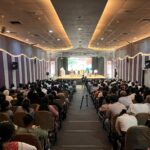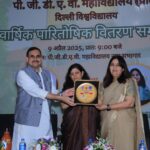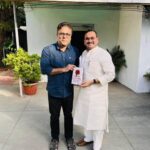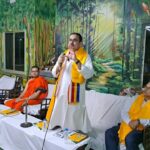IN MEMORY OF INDIA’S LITTLE SISTER
- By : Anirban Ganguly
- Category : Articles
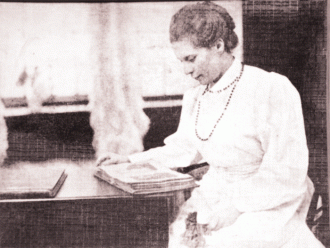
As we observe Sister Nivedita’s sesquicentennial this year on October 28, it would be worthwhile to use this day as an opportunity to meditate and delve into her boundless love for India and into the dimensions of her selfless action for India’s self expression
India is one. How much of India is one? Just so much, dear friend, as can summon up strength to realise the fact! India is one. But she is so disunited! Is she? Look again! Look facts in the face. Break through all hypnotism. Fear not. Go deep down into the truth of things. It may be that you shall someday say that never was there a country so united, so woven together in all their parts, so fundamentally one, as this India of ours.” In her short stay of about 13 years in India and through her immersion in the vision of India that her master, Vivekananda articulated, Sister Nivedita had realised and had, without reserve, identified herself with that fundamental unity of India.
Who else but one who had completely internalised India and drank from her civilisational fount and re-discovered the inner flows of her unity could write a “Daily Aspiration for the Nationalist” as Nivedita had done. “I believe that India is one, indissoluble, indivisible. National unity is built on the common home, the common interest and common love. I believe in the strength which spoke in the Vedas and Upanishads, in the making of religions and empires, in the learning of scholars, and the meditation of the saints, is born once more amongst us, and its name today is nationality. I believe that the present of India is deep-rooted in her past, and that before her shines a glorious future.”
In an assessment of Nivedita’s life, one of her foremost biographers, Pravrajika Atmaprana, made a moving assessment of her fundamental contribution to our national life. “The greatest work”, wrote Atmaprana, “that Nivedita did for India was to treasure what she got from Swamiji and hand it over to future generations through her writings and lectures. The theme of all her writings, including letters, which run into thousands of pages, is this: Swamiji and India, Swamiji in India, and India as reflected in his mind and heart.”
Describing Nivedita’s one-pointed articulation of her master’s vision of India, Bengali littérateur Mohitlal Majumdar wrote, “a lotus is doubtless a big flower; but still it does not blossom without sunlight. Swamiji was the sun that made the lotus called Nivedita bloom. She loved India and dedicated her whole life to its service…Swamiji made Nivedita see India with the eyes with which he had seen this great country. It is almost as if he had implanted his own heart within her bosom.”
When asked sometime towards the end of 1902, during a visit to Madras, on what will be her future work in India, Nivedita simply replied, “My life is given to India. In it I shall live and die.” Such words more than adequately describe the depth of her total consecration to India, her people and to its future. Nationalist intellectual history is almost always ignored and overlooked when analysing Indian history and in it Sister Nivedita’s contribution, her role in generating the yearning for selfhood is almost always ignored or forgotten.
Sister’s action for India extended in many directions — there was her political and revolutionary action, action for education, cultural action, civic action — for cleanliness she was an earliest and most active proponent for swacchta — her action for the empowerment and emancipation of Indian women — and through her work in each of these fields she harped upon the consolidation of national thought and of national unity. Through each one of her actions she attempted to weave the triple aspects of “jana–desh-dharma” into a grand and mutually-sustaining and upholding unity. The sole aspect that she strove to work for and fructify was that of national unity, and even in that her convictions were contrary to the general belief of the age then and probably even now, “We are one! We have not to become one. We are one. Our sole need is to learn to demonstrate our unity.”
Saralabala Sarkar, author and poetess who had come in contact with Nivedita through her action in the field of education in Calcutta, movingly describes, Sister’s intense emotion for India. Her description is a lesson in itself, an exercise that begins to reveal to the inner eye the nation as the mother herself. “How often have we seen Nivedita in deep absorption at some thought”, remembered Saralabala, “If any talk of India arose, she would become deeply meditative and say to the girls, ‘Bharat Varsha! Bharat Varsha! Bharat Varsha! Mother! Mother! Mother! India’s young girls, you must all repeat, Bharat Varsha! Bharat Varsha! Bharat Varsha! Ma! Ma! Ma!’ So saying she would take her rosary and start doingjapam herself. That India was the soul of her soul, the heart of her heart, ever so dear and sacred to her, cannot be expressed in mere words.”
So dynamic was her action, so meteor-like its appearance and symbolism and so wide all encompassing and compassionate its contour, that it inspired Rabindranath Tagore, to describe her in these words, “She was indeed a Lokmata, a mother to the people. We are familiar with the mother’s role in a family; but the image of a mother whose love enfolded a whole people was something we had never seen before…So genuine was Sister Nivedita’s love of the people that those who had observed it could easily see the difference between her love and our concern for the people…”
The entire corpus of Nivedita’s work is scattered with articulations and positions that remain as profound and as relevant today as when they were first written. In her series on “Civic Ideal and Indian Nationality”, one of her best formulations on nationality, nationalism, national unity and the evolving national movement in India one continuously comes across such perceptions and arguments as when she wrote, “What the national movement as a whole has to do is to nationalise and vocalise two great areas of moral force that are at present nationally almost mute. These areas consist of the women and peasants. Let every student in the city colleges band themselves together and take a vow to maintain at least one missionary for this purpose…” While discussing the need for careers to be “open to ability”, for example, she argued that “education must be absolutely democratised, in order that all talents may be discovered, and the remaking of the Swadesh may proceed apace.” For Nivedita, as she wrote, the ideal and idea of “Indian nationality” could be recovered today only if the “the common man recognises in himself a love for India, and a responsibility to her interests…”
And yet in the end she preferred to be always accepted and remembered as a “little sister”, as she wrote in an open letter to Indian women, “I beg of you always, — for his sake, who made me his daughter and, therefore, your country-woman, — to think of me and pray for me as your little sister who loves this beautiful and holy land, and who longs only to be shown how to serve you more and more effectively…”
Sister Nivedita’s sesquicentennial, starting on October 28 this year, offers an opportunity to meditate and delve into her boundless love for India and into the dimensions of her selfless action for India’s self-expression.





